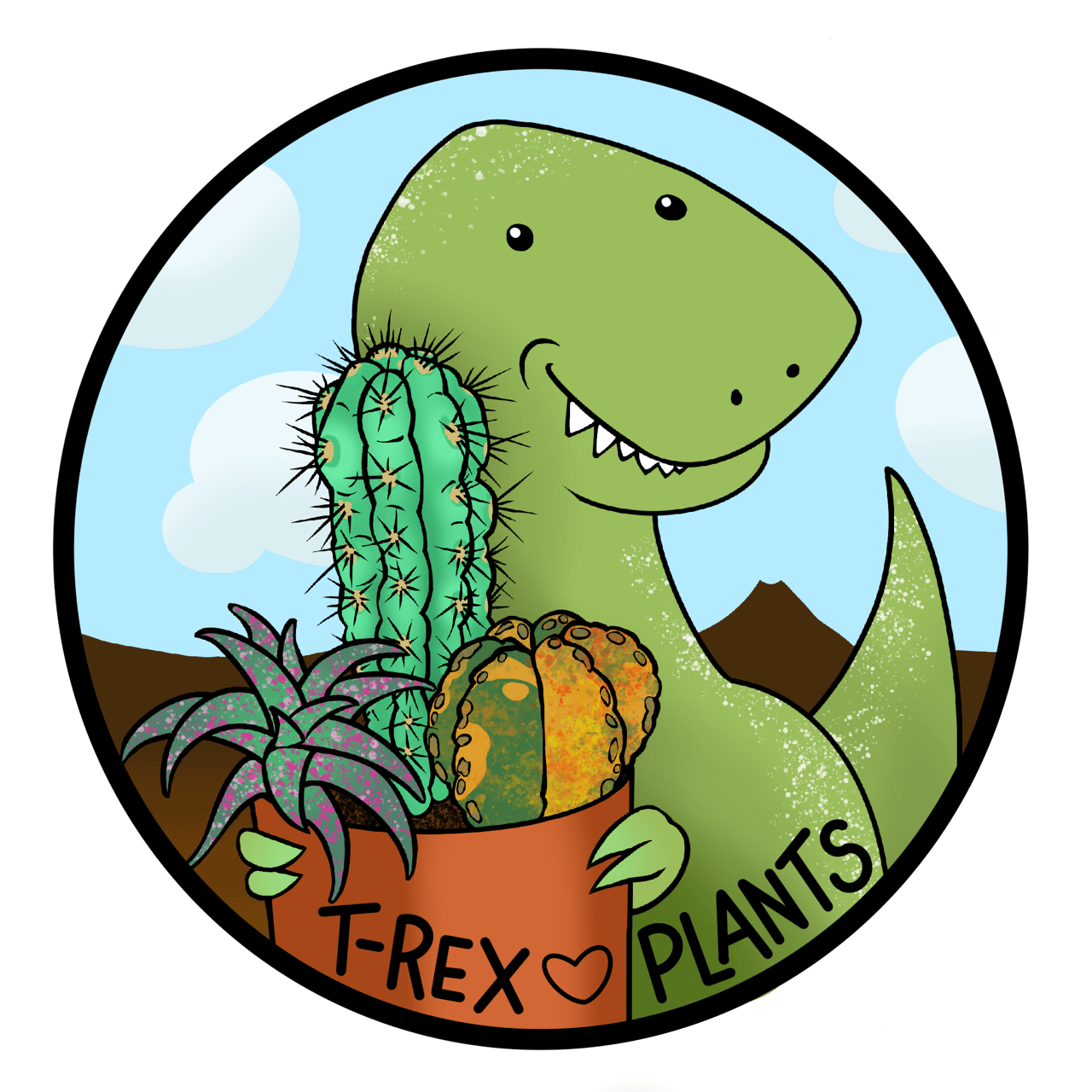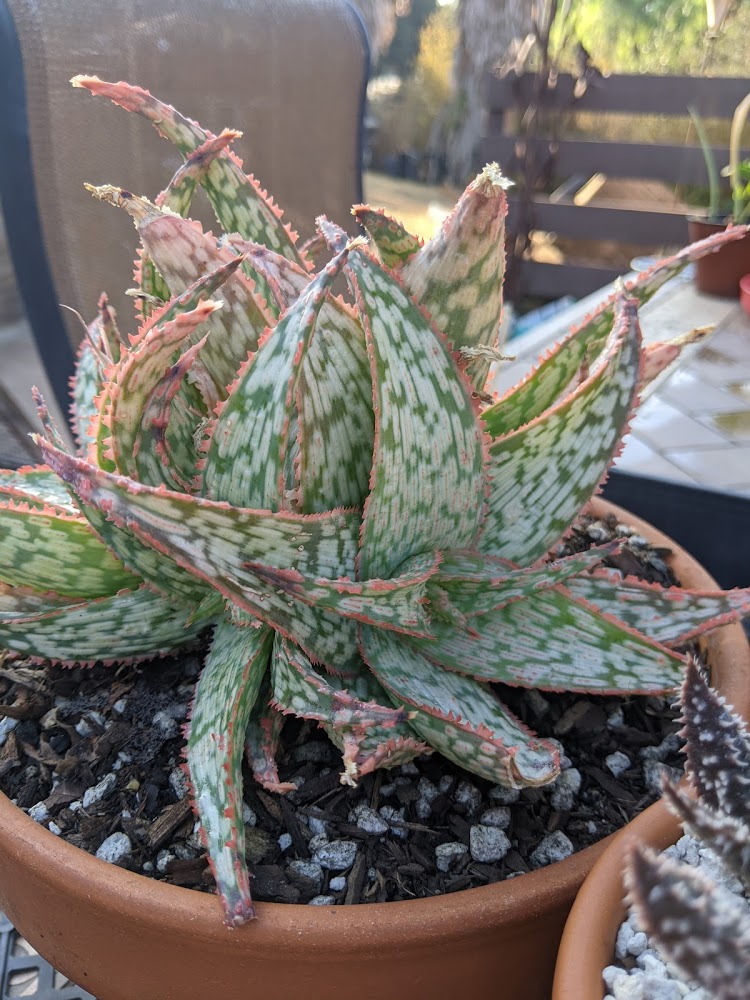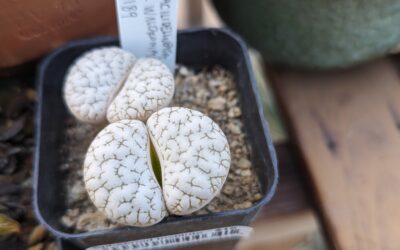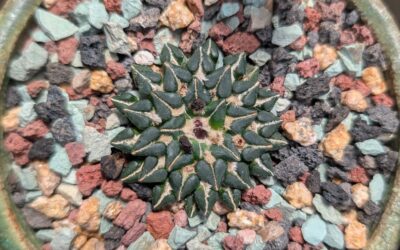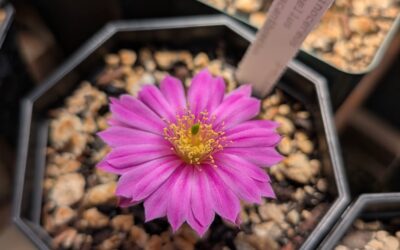New in the collection as of October
Because I have what some people might consider “a problem”, I tend to add anywhere from a handful to a few dozen new plants to the collection each month. Since they won’t have any care history or series of photos to go along, I’ll lump them together to show the newest plants in my collection and how they look when first arriving. As time goes on, plants will get their own posts, but for now this can be a fun view of what is locally available and popular in San Diego.
Haworthia emelyae – Glass Window Haworthia
There’s gotta be at least 50 types of glass window or cathedral haworthias, and for some reason, I need all the flat top types. Compared to my Haworthia mirabilis types, this one has a more matte look to it, and more textured leaves. Referencing Doreen Court’s Succulent Flora of Southern Africa, H. emelyae ranges from the Swartberg Mountains in the northern edge of South Africa, down to the Langeberg mountains further south. This one is definitely the species-type, and I may need to repot it in a smaller pot – reading the description, they don’t form clusters like the mirabilis, and instead grow a rosette of up to 20 leaves. I’m hopeful with some sun stress it’ll develop the purple-ish brown coloration with flecks of pink.
When it comes to staging this, in-situ photos seem to point at them growing fairly close to the ground, with most of their leaf bodies hidden below the substrate. Their stressed coloration with brownish shades blends in well to the sandy, clay-looking soil pictured. Mine is currently preparing to throw a bloom, and I may keep two just to try and set pure seed.
These are also available in my Etsy shop! You can pick up these, as well as the Haworthia mirabilis var. mundula, while they’re in stock.
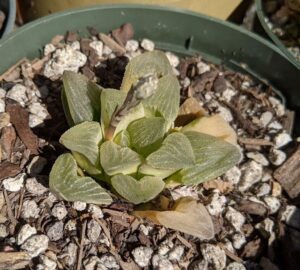
Kelly Griffin Aloe Hybrids – Mauna Kea, Tarantula, and Aloe castilloniae “Blue”
I’ve been stalking my local wholesaler and visiting every few days over the last couple weeks, because they’ve been releasing large, specimen-sized plants of coveted aloe hybrids for quite cheap. I almost snagged an Aloe suzannae to be a pair with the one I already have, but they are such slow growing aloes (and mine has not grown significantly since I put it in-ground) that I decided against it. I’ll keep mine as a specimen plant to hopefully look beautiful and impressive in 10 – 20 years, but for other beautiful succulents to include in my collection, I chose these large hybrids.
The first was this Aloe castilloniae hybrid “blue”, which I’d never seen before and knew immediately I had to have it. I’ve staged it in a tall, three legged pot and I’m hopeful by next year I’ll be able to keep it clean and appropriately stressed to place at our local cactus show, if that ever happens in person again. It has distinct similarities to my other Aloe castilloniaes, and with it throwing blooms, I plan on crossing it to the others for some seed. Should make for some interesting and varied offspring! I have it in nearly full sun after a few days of acclimation to my area, and may move it to more shade to encourage the blue coloration to come through rather than the intense brown/purple shade it’s become.
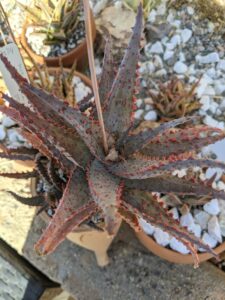
The second was an Aloe x Gasteria hybrid, a variety named “Tarantula”. If you look at the tag, it’s noted as a sport from a second generation (F2) offspring of the cross. An internet search notes from Dave’s Garden that Kelly Griffin described it as a sport from ‘Twilight Zone’ that was then named Tarantula. It’s super neat, and I’m hopeful it’ll develop into a robust cluster with brighter pink and orange fuzz to it. For now, I have it potted in a well draining soil, with plenty of pumice to encourage root growth. When I originally unpotted it, the roots had clearly rotted out, but it was sending out new ones to replace the ones lost. With plenty of sunlight, regular but less frequent water, and time, I’m confident it’ll throw a new robust set of roots that will nurture new pups to appear.
I have it in terra cotta to ensure that the soil doesn’t stay too moist for too long, which seemed to be the problem in its previous plastic pot. Its previous soil medium was also much higher in organic matter, which holds moisture longer and again, likely contributed to the root challenges. It’s okay! That stuff happens. The plant tag seems to point at this being a 2018 or older plant, and with that much time in a plastic nursery pot and organic soil, it’s hardly surprising.
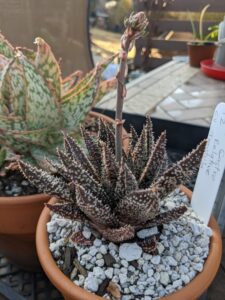
Peeking in the corner behind the tarantula, you can also see my new gorgeous Mauna Kea aloe hybrid.
This hybrid is a challenge to find information for online, but this plant is big, beautiful, with rich pink-orange edging and a white to pink blushing on the leaves. The one I picked up is large – I’ve potted it into a 10″ terra cotta pot and the leaves are touching or hanging over the edge already. It had robust roots, and tons of pups, but they’re so compact and tightly grown I couldn’t get any pups off to try and trade with friends. As with the others, it was in a soil blend with lots of organic material, so I have it in a blend with more pumice and perlite for drainage. After a few more days protected from our typical sunshine, I’ll move it to the aloe garden area with my other hybrids.
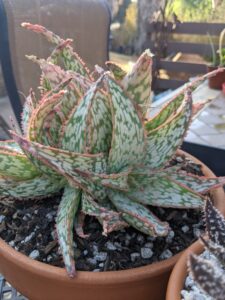
Moving Into Mesembs – Schwantesia borcherdsii
These are super pretty, pale blue mesembs with branching leaves. I’d never seen them before, which meant that naturally I needed a few. So far, they seem to do well in my typical lithops/mesemb mix, although finding an ideal balance of water has been a bit of a challenge. Reading in Mesembs of the World, the species occurs in very arid areas, and should be protected from too much moisture. It recommends greenhouse cultivation with sandy gravel, which is similar to my mesemb soil blend. The genus is closely related to Lapideria, and the color of the leaves is very similar. I’ve kept three plants to try and set seeds eventually. As of right now, I also have several for sale in my shop.
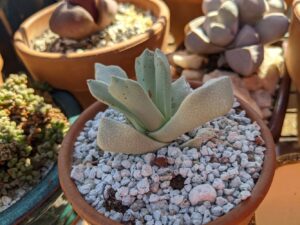
New Copiapoa – tiniest species in the genus, Copiapoa laui
If you aren’t on Instagram and seeking out the plant community there, you’re missing out. I spotted one of my favorite sellers posting this little Copiapoa, and snapped it up for myself. Mine is definitely a little misshapen, but I’m confident with some time and tender care in the form of loving neglect, it’ll become a very neat specimen plant. I potted it into a nearly entirely inorganic soil blend, mostly pumice with some sand and a small (read: pinch) of premium cactus/succulent soil from a local nursery. This harsh soil should help ensure excellent drainage and rapid drying out of the soil, which copiapoas need to thrive. After a few days acclimating, with morning sun and afternoon shade, I’ve moved it to an area that gets nearly 90% direct sun for most of the day. It’s nestled between some other pots, so it’s still somewhat shaded at different times, which is allowing it to slowly acclimate further to the intense sun. It is quite green for its species, indicating greenhouse growing conditions and filtered light, so the slow adjustment to full San Diego sun is necessary to ensure it doesn’t scorch the way my first Copiapoas did.
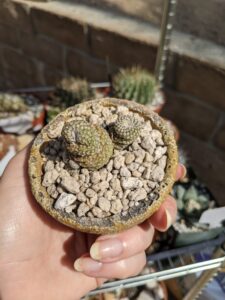
Monstera “Peru”
Last, but definitely not least, is a new tropical addition. I add to my tropical plants much less often than my cacti and succulents, due to space and care constraints. When I add a new tropical plant, it needs to be something I really enjoy and want to dedicate the space and effort to. I also need to be able to quarantine it away from my other plants for a while; some folks recommend 90 days or more, but I tend to do about 30 days and evaluate from there. For now, it’s in a terra cotta pot with a grow pole and hangs out with some grow lights in my office with me for its quarantine period.
This plant is a Monstera “Peru”, which has also gone by Monster karstenianum. It’s a lovely climbing plant that is hardy, easy, and has beautifully thick, textured leaves that are naturally two-toned. It’s also enormously easy to grow by all internet accounts, and the few weeks I’ve had this in my care has held that up. I potted it directly in Happy Frog indoor potting soil, with a little bit of perlite and orchid bark mixed in to ensure drainage and soil aeration. Humidity is just average home humidity, 40 – 60%, and I’ve watered it only a couple times. Being under grow lights and a plant with thick, firm leaves, it’s one that likes to be somewhat dry before getting watered again. I’ve been bringing it into the shower for each watering as well, to ensure all the leaves get well rinsed and washed, and that the soil fully flushes.
The photo below shows the plant immediately after being unboxed, potted, and rinsed in the shower. Since this photo, taken in the first week of October, the leaves have started to point up towards the grow lights, and it’s putting out new leaves on each vine.
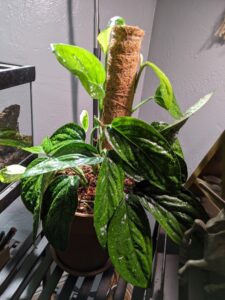
Hopefully, all of these plants thrive for me and continue to grow and develop character with time! Check back regularly for updates as they grow.
